Growing and caring for maned barley and its application in landscape design
Barley has been known to man since ancient times as a valuable food crop. Even in ancient Palestine, 17 thousand years ago, the Jews raised it for livestock feed and for the production of cheap flour. For the poor, barley bread was a popular and constant food product.
Over the long history of barley cultivation, people have mastered 12 of its wild-growing species, one of which has an exclusively decorative purpose - maned barley. This cereal can give a mesmerizing look to a mixborder and become a real highlight of the garden. Consider the features of planting and caring for this plant.
The content of the article
What is Maned Barley
Popular plant of alpine slides and rockeries, maned barley has long earned itself a place of honor among the other favorite plants of landscape designers. One of the main advantages of culture is the combination of unpretentiousness with long-term decorative effect.
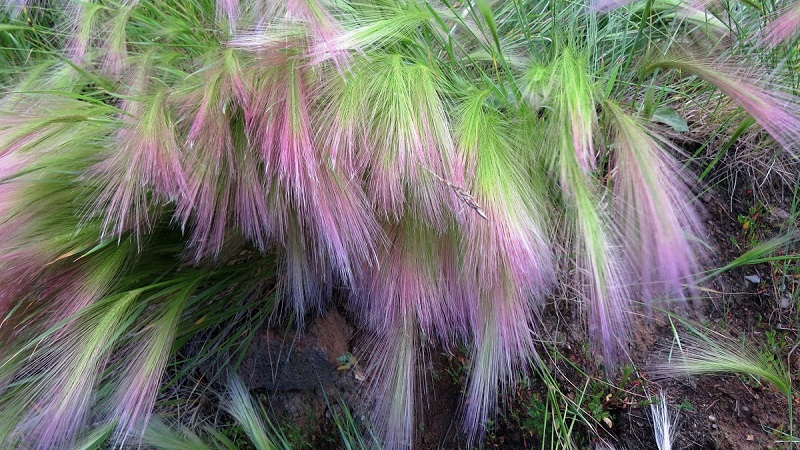
Description and characteristics of the plant
Maned barley (Нordeum jubatum) belongs to perennial plants of the Cereal family (Gramíneae). The root system is powerful, fibrous. The culture is a dense sod perennial with a shortened rhizome and thin smooth gray-green stems growing up to 40-50 cm.
The leaves are arranged alternately on the stem. The leaf blade is bright emerald in color, linear, with a pointed tip, silky, up to 3 mm wide and up to 12 cm long.
Inflorescence - complex ear... One stalk contains three simple spikelets in one spike, up to 8 cm long. Spikelet scales are long, thin, protruding. It is they who make the maned barley so beautiful. The lower spikelet has a long reddish-purple axis. The fruit is a weevil.
Attention! Do not confuse maned barley with steppe feather grass! These are completely different species of the Cereal family.
History of appearance
Under natural conditions, the plant grows in the steppes of northeast Asia and pastures in North America... The first scientific name of the cereal was given by Karl Linnaeus in 1954 for the characteristic pubescence of the spikelets. With the advent of new railway lines, the grain began to spread over longer distances.
The settling of maned barley in Russia took place in the second half of the 20th century. The scientist D. P. Syreishchikov, a specialist in the flora of Central Russia, in 1914 for the first time collected his herbarium in the Moscow region (Khimki). Today this plant grows along the railways of Eastern Siberia and the Volga-Don region.
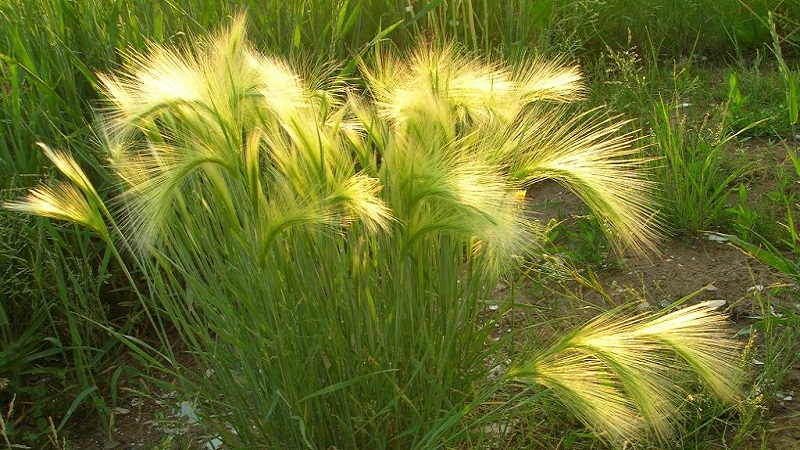
Household purpose and application
Maned barley is an exclusively ornamental plant that is used in landscaping both city squares and parks, and private gardens, as well as dried flowers for floristic compositions.
In some literature, it is even found as a weed that infests agricultural fields. It is also harmful to cattle. Its green mass, getting into feed or hay, causes irritation of the digestive tract and even ulcers in animals.
When the flowering of maned barley comes
In July, lush inflorescence caps appear above the barley clumps, hovering and airy like clouds that sway from the light breezes of the wind. Spike-shaped inflorescences are slightly curved in the stem.Young spikelets are colored silvery-green, with time they acquire a straw-yellow color. The spikelet bristles are soft and long, with a reddish-purple tint.
The magnificent flowering lasts for two months, seeds begin to ripen in September... When dry, the plant retains its decorative appearance until frost.
Reference. If the inflorescences are cut in time (before the start of seed formation), repeated flowering is possible.
Application in landscape design
Maned barley is ideal for mixborders and perennial flower beds... The plant looks especially impressive on open rocky areas, rock gardens, lawns.
Decorative barley is planted in flower beds, and the voids are filled with it after early spring flowers have faded.
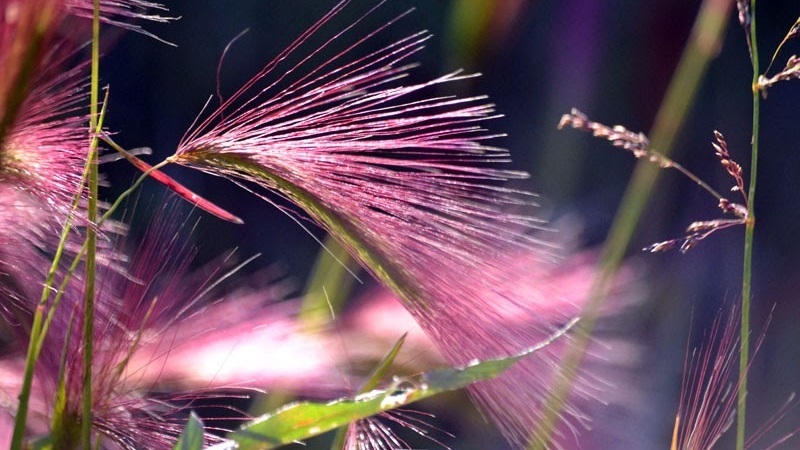
Barley inflorescences stand well in bouquets and retain their shape and color, which allows them to be used to create dry flower arrangements in the interior. Inflorescences for bouquets are cut only at the beginning of earing.
Late cut ears can break apart after drying in a bouquet into separate parts.
Maned barley goes well with:
- decorative cereals and dried flowers (millet, blue fescue, cortaderia, miscanthus, haretail);
- flowering annuals (Iberis, Levkoy, Lobelia);
- perennials with a silvery leaf color (aster, bicolor rosemary, sage, lavender);
- flowers with bright purple, red or orange hues (marigolds, calendula, zinnia, low-growing amaranth varieties, coleus).
Other decorative crops:
Decorative pepper "Capsicum": growing and care
Landing rules
The technology of planting maned barley does not differ from planting other flower crops. For plants to successfully take root, you need to know its preferences and the best sowing time.
Timing
Sowing of maned barley can be done both in spring and late summer... When sowing in spring, the plants bloom in the same summer, but when planted before winter they turn out to be stronger, with a well-developed root system and have accumulated sufficient vegetative mass. Autumn sowing is most rational for long-term cultivation of this cereal (in the southern regions, where the winters are mild and moderate).
Optimal terms:
- first half of April (for flowering in the year of planting);
- second half of August - early September (flowering next year).
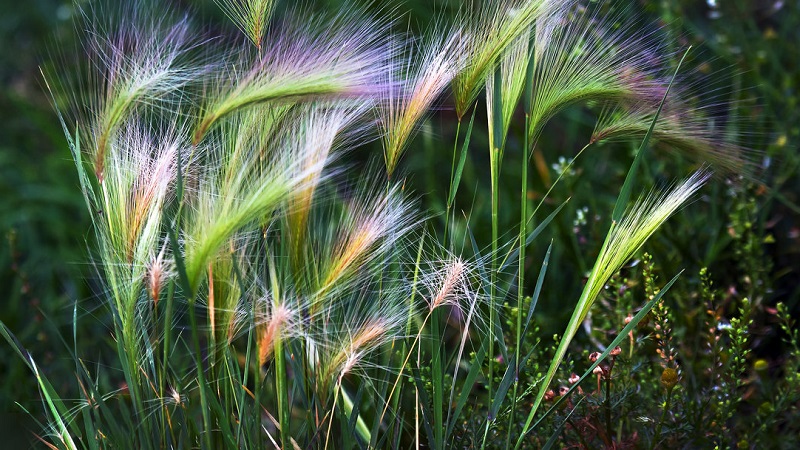
Place on the site
For planting a perennial choose a flat place with good lighting throughout the day... The plant loves bright sun and is not afraid of drought. If there is no such place on the site, plant the cereal in partial shade. Flowering will not be so plentiful, but the decorativeness of the flower will not suffer greatly.
The choice of soil for cereals should be taken seriously.... The plant does not tolerate the slightest stagnation of water and close standing of groundwater. Heavy soils with a high clay content are also not suitable for it. Fertile, well-drained loams are considered the best soil.
Soil preparation
For barley, loose soil is ideal, nutritious, light in texture, permeable and slightly acidic or alkaline. Soil preparation on the site for planting crops should consist of several events:
- Autumn digging with the introduction of 1 bucket of humus and 2 tbsp. l. phosphorus-potassium fertilizers per 1 m².
- Manual thorough removal of weeds and their rhizomes.
- Spring loosening of the soil two weeks before planting to a depth of 15 cm.
On sandy soils, poor in organic matter and mineral composition, the cereal, although it will grow, does not form a lush turf.
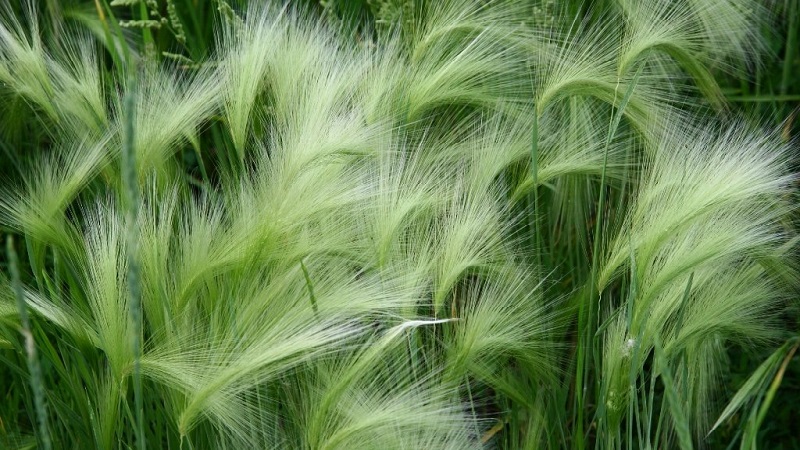
Seed preparation
Ornamental barley is usually sown in the ground with dry seeds., but if there is a desire, the germination process can be accelerated with the help of simple methods of pre-sowing seed preparation using stratification (keeping in the cold).To do this, a layer of sand and peat is poured into a flat container, over which barley seeds are laid (photo).
From above, the crops are covered with a layer of peat and moistened. The containers are covered with foil and placed in a cool place (on the lower shelf of the refrigerator or on an unheated balcony) for two weeks.
Rules for planting seeds in open ground
The technology of sowing seeds in open ground consists of several stages:
- In May, when the threat of frost has passed, grooves 15 cm deep are made along the prepared area.
- Seeds are laid out in the grooves with an interval of 3-3.5 cm.
- Close up with fertile soil and watered.
- When shoots appear, they are thinned out so that a distance of 5-6 cm is maintained between the plants.
Growing seedlings and planting seedlings
The seedling growing method is used if you want to get barley flowering a month earlier... Seeds are sown in mid-March. For this:
- Seedling containers are filled with a mixture consisting of 2 parts of humus, 1 part of peat and 1 part of sand.
- The seeds are placed on the surface of the soil, slightly pressed into the soil and sprinkled with peat.
- The top is moistened with a sprayer.
- Water as the top layer of the earth dries up.
- When the fourth true leaf appears on the seedlings, they are planted in separate pots.
- Plants are kept on a warm windowsill (+ 20 ... + 22 ° C) until May 10, after which they are planted in open ground.
- When planting in a permanent place, it is important not to damage the fragile root system.
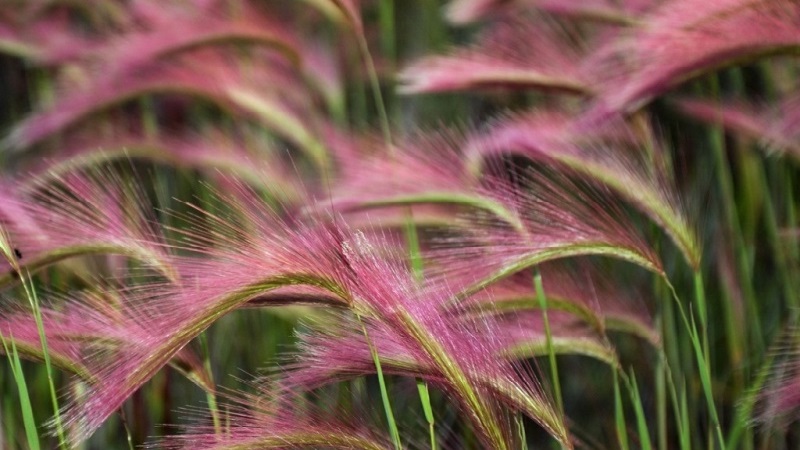
Optimal conditions for seed germination:
- temperature - + 14 ... + 16 ° C;
- air humidity - 65%;
- diffused light.
If you want to make a beautiful flowering cereal bloom earlier, but there is no desire to deal with seedlings, plant barley in March in a greenhouse. With this sowing, the plants will quickly begin to grow, and flowering will begin in June.
Read also:
What does the decorative pumpkin "Little Red Riding Hood" look like?
Care features
Only young, immature plants need careful care.:
- The grown seedlings often suffer from weeds damping. To keep them air, food and light, weed regularly and loosen the soil crust regularly.
- In order for cereals to quickly grow a curtain, apply a complex mineral fertilizer (Fertika Universal-2). Application rate - 30-40 g per 1 sq. m.
- Young plants need moderate watering, adults - rare. Drought-resistant barley needs water only during drought periods (if there is no rain for 1.5 weeks).
Further care for adult plants includes rare watering, systematic loosening and weeding, one top dressing with mineral complex fertilizer per season. In addition to the traditional cultivation of barley as an annual or perennial, there is also a "shift" method of cultivation. At the end of September, the plants are dug out of the flower garden and transplanted into containers. The planted flowers are kept in the house (if there is a room with a temperature of + 18 ... + 20 ° C) or on a heated balcony.
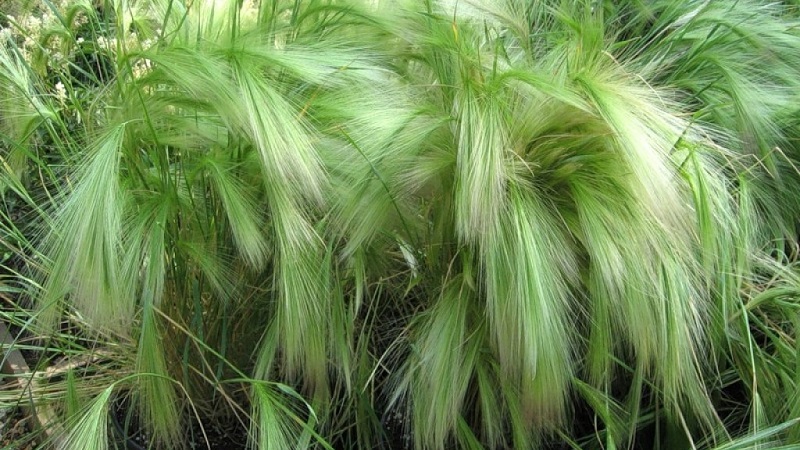
Tips & Tricks
Difficulties with the agrotechnology of maned barley usually do not arise... Many gardeners grow it as an annual crop - in winter, this perennial often grows out or freezes out.
If winters in your area are suitable for perennial crop cultivation, do a rejuvenating shrub division in the spring. With good care, cereals can grow to a height of 50 cm. To make the curtains look neat, tie them to an inconspicuous support, such as bamboo sticks.
Conclusion
Maned barley is an unpretentious crop. In addition, it is almost not affected by pests and diseases. Only prolonged rains and lack of soil air exchange can severely harm the plant.
Using it in landscaping, you can create a romantic garden or imitation of a blooming steppe, revive a mixborder and add a fountain of silky ears to it.